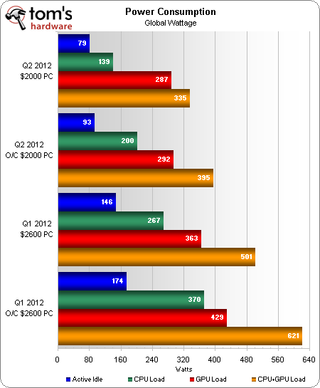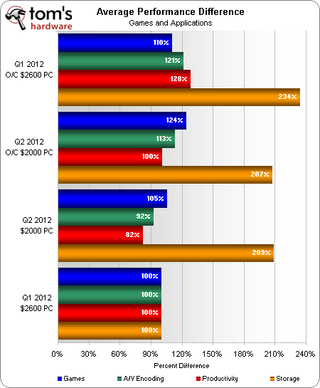System Builder Marathon, June 2012: $2000 Performance PC
Power, Heat, And Efficiency

We knew that this month’s Ivy Bridge-based CPU and Kepler-based GPU would draw less power at idle than our former build’s Sandy Bridge-E and Cayman parts, but we were still surprised to see just how much power is saved by more efficient hardware. The new build uses less energy at full load than its predecessor, even when comparing its overclocked configuration to the former build’s baseline.

The new machine’s actual power consumption at the wall is less than 400 W, which means the power supply’s output was less than 360 W (according to its efficiency test sheet). If a possible SLI upgrade isn’t enough for your future-proofing needs, consider that you could run two of these complete platforms from just one of its 750 W-output power supplies.
Less power often means less heat, but we’re fully aware of the problems many Ivy Bridge-based samples have in transferring heat from the die to its integrated heat spreader. We were further disappointed to find that the only available GeForce GTX 680 graphics card uses an internally-venting cooler, increasing the temperature of the ambient air responsible for cooling the -3770K. Thus, we weren’t surprised to see a mere 1.25 V core setting push its full-load temperature to 56.4° Celsius above room temperature.

These temperature readings were taken with eight threads of Prime95 (small FFTs) running simultaneously with 3DMark 11’s first test looping, for around 30 minutes, representing a worst-case scenario.

Average performance is used to calculate both our performance-value and efficiency scores, and since this page centers on power consumption, we begin with efficiency. Overall performance is calculated using 30% games, 30% encoding, 30% productivity, and 10% storage scores.
Using our previous machine’s baseline configuration as the base for our calculations, we begin by making a direct percentage performance score for each machine. We then make an inverse power percentage calculation by dividing the baseline by each system’s actual power consumption, to award the highest power score to the machine that consumes the least energy.

The higher productivity and drive performance scores put last quarter's overclocked build on top of our performance charts. However, far lower power consumption gives the new system a huge efficiency advantage.
Current page: Power, Heat, And Efficiency
Prev Page Benchmark Results: Productivity Next Page Gamers: You're Going To Love This One!Stay on the Cutting Edge
Join the experts who read Tom's Hardware for the inside track on enthusiast PC tech news — and have for over 25 years. We'll send breaking news and in-depth reviews of CPUs, GPUs, AI, maker hardware and more straight to your inbox.
-
vakuma5000 Awesome Build!!Reply
I have the exact same GTX 680 from ASUS, and I love it. Managed to get 1337Mhz out of the core and 6800 out of the memory. I achieved that with only 115% power limit. If I raise the power limit any higher, i start to loose performance and stability. That is a truly awesome memory oveerclock you got out of it! Congrats!
Very much looking foreward to the value comparison.
Would LOVE to see the 1800$ build win the value comparo!
GO GTX 680!!
My vote goes towards keeping a gaming focus as opposed to a more "all-in-one" type build.
Love the System Builder Articles, love Toms! -
vakuma5000 Unfortunately GTX 680 availability is still pretty spotty.Reply
Had to spend 2 days on newegg, refreshing the page every few mins to get the model i wanted.
However, it IS looking better. They are listing them more often on newegg, and they don't sell-out as quickly as they were a few weeks ago.
Check newegg daily from 5:30pm to 6:30 pm CST, and you should be able to catch one.
The GTX 670's are in stock right now.
Good luck rohitbaran! -
slicedtoad Replyshould we keep the gaming focus or move back towards higher-cost do-it-all machines?
Personally, I'm happy with the gaming focus. Don't know how others feel but gaming performance is more important than productivity benchmarks for me. I compile a lot of code and do some video encoding but I find gaining fps in games is more important than shaving seconds off my work. Besides, productivity follows gaming performance close enough.
On another note, I dislike value comparisons when things like SSD size and optical drives have made an impact in price. A larger SSD does nothing for a benchmark but is awesome in practice. I'd prefer only comparing the combined price of the gpu, cpu, cooler(s) and mobo in the value chart. That's not a perfect solution but it annoys me that things like high quality PSUs, nice cases, blu-ray burners and large SSDs throw things off so much. -
Crashman strandiamSo many great cases to choose from with so many great features....Perhaps the award-winning NZXT Phantom 410 next time?Reply
http://www.tomshardware.com/reviews/mana-136-midgard-ii-phantom-410,3203-5.html -
sam_fisher CrashmanPerhaps the award-winning NZXT Phantom 410 next time?http://www.tomshardware.com/review 203-5.htmlReply
My only dislike about this build is the case, for a $2000 PC I would prefer a case that was tidier and larger than the Antec Nine Hundred (especially with the layout of the HDD bays). The NZXT Phantom 410 would be much better for that budget.

